
On March 30, 2022, the U.S. Securities and Exchange Commission (the “Commission” or “SEC”) proposed new rules and amendments regarding special purpose acquisition companies (“SPACs”), shell companies, and disclosure related to projections. The proposed new rules and amendments would, among other things, if adopted:
- Enhance disclosure requirements related to SPACs and de-SPAC transactions to more closely align with the requirements of companies engaging in a traditional initial public offering (“IPO”) process;
- Expose private target companies and their directors, as well as investment bankers involved in a de-SPAC transaction, to the same liability under Section 11 of the Securities Act of 1933, as amended (the “Securities Act”), for material misstatements or omissions in S-4 registration statements that such parties would have in a traditional IPO; and
- Remove “safe-harbor” protections under the Private Securities Litigation Reform Act of 1995, as amended (the “PSLRA”), relating to the use of projections in de-SPAC transactions, and impose heightened disclosure requirements in connection with the use of such projections.
A known focus of Commission Chairman Gary Gensler since May 2021 when he discussed devoting significant Commission resources to addressing issues in de-SPAC transactions to the House Appropriations Committee, the proposed rules and amendments would require more fulsome and transparent disclosure in such transactions. The Commission’s goals appear to be twofold: first, to make the disclosures involved in de-SPAC transactions more analogous to those in a traditional IPO process; and second, to more prominently highlight the potential conflicts of interest between the sponsor of a SPAC and its public shareholders. Chairman Gensler was quoted as saying “[f]or traditional IPOs, Congress gave the SEC certain tools, which I generally see as falling into three buckets: disclosure; standards for marketing practices; and gatekeeper and issuer obligations. Today’s proposal would help ensure that these tools are applied to SPACs. Ultimately, I think it’s important to consider the economic drivers of SPACs. Functionally, the SPAC target IPO is being used as an alternative means to conduct an IPO. Thus, investors deserve the protections they receive from traditional IPOs, with respect to information asymmetries, fraud, and conflicts, and when it comes to disclosure, marketing practices, gatekeepers, and issuers.”
The public comment period will remain open for 60 days following publication of the proposing release on the SEC’s website or 30 days following publication of the proposing release in the Federal Register, whichever period is longer.
Background
SPACs are typically shell companies formed for the purpose of merging with or acquiring a private target company. Many companies and investment bankers believe that the SPAC transaction structure allows private companies greater certainty regarding valuation and a quicker “going public” timeline than a traditional IPO while offering the ability to provide and use projections in the de-SPAC filings made with the Commission. As a result, certain private companies have favored the de-SPAC transaction structure over a traditional IPO.
However, during the recent surge in SPAC formations and completions of de-SPAC transactions, a variety of market observers have raised concerns about, among other things, the nature and disclosure of SPAC sponsor compensation; potential conflicts of interest that could incentivize SPAC sponsors to enter into de-SPAC transactions that are “unfavorable” to public shareholders; the use of projections that, in the view of some market participants, appear to be unreasonable, unfounded or potentially misleading; and the lack of a traditional gatekeeper similar to the role played by underwriters in IPOs.
As a result of such concerns and as the number of SPAC IPOs and de-SPAC transactions increased exponentially over the past 30 months, the Commission already issued guidance on SPACs five times since December 2020, leading up to the current, more comprehensive rulemaking proposal.
Summary
The new rules and amendments, if adopted as proposed, would:
- Enhance Disclosure. Require enhanced and more prominent disclosure regarding, among other things, SPAC sponsors, potential conflicts of interest, stockholder dilution and fairness of the transaction to SPAC investors (which would require the SPAC to disclose whether or not it received any report, opinion or appraisal from a third-party regarding the fairness of the consideration to be offered to security holders) pursuant to a new subpart 1600 to Regulation S-K.
- Require Additional Information about the Target in any S-4 Registration Statement and treat the Target as a Co-Registrant. Amend Form S-4, the registration statement generally used in de-SPAC transactions, to require additional disclosures about the private target company that are similar to disclosure requirements on Form S-1 for an IPO. Additionally, the proposed new rules and amendments would make a private target company a co-registrant with respect to any registration statement on Form S-4, thus making the private target company and its signing persons (directors and certain executive officers) subject to liability under Section 11 of the Securities Act for any material misstatements or omissions in the registration statement.
- Modify the Treatment of Projections.
- Propose a definition for “blank check companies” that would eliminate the safe harbor for forward-looking statements under the PSLRA, including with respect to the inclusion of projections of private target companies.
- Seek to increase the reliability of projections in filings with the Commission, as well as impose additional requirements when projections are disclosed in connection with de-SPAC transactions according to proposed amendments to Item 10(b) of Regulation S-K. Among other things, the proposed amendments would require: (i) clear delineation between historical results and future, projected measures; (ii) the presentation of a historical measure with equal or greater prominence when providing projections based on historical results; and (iii) clear definitions and explanations of non-GAAP financial measures and why such non-GAAP financial measures were used compared to a GAAP measure.
- Require additional disclosures including: (i) who prepared the projections and for what purpose; (ii) all material bases of the disclosed projections and all material assumptions; and (iii) whether or not the projections still represent the view of the board or management of the SPAC or private target company as of the date of the filing of the registration statement or merger proxy statement and if not, then a discussion of the purpose of disclosing such projections and the reason for continued reliance by the management or board on the projections pursuant to a new Item 1609 of Regulation S-K.
- “Re-Install” Gatekeepers. Treat anyone who has (i) acted as an underwriter of SPAC securities and (ii) either (a) aids or assists in the de-SPAC transaction, (b) aids or assists in any related financing transaction (e.g., a PIPE transaction), or (c) otherwise participates in the de-SPAC transaction, as being engaged in the distribution of the SPAC’s securities and subject to Section 11 underwriter liability in the de-SPAC transaction pursuant to a new Rule 140a under the Securities Act.
- Require Financial Statement Disclosures Similar to IPOs. Require financial statement disclosure in de-SPAC transactions to more closely align with those in a traditional IPO provided on Form S-1 pursuant to a new Article 15 of Regulation S-X.
- Potentially Delay Special Meetings. Require registration statements and merger proxy statements be provided to SPAC stockholders at least 20 calendar days in advance of a stockholder meeting to approve the transaction thus allowing SPAC stockholders more time to review often complex disclosure documents.
- Compel Re-Evaluation of Filer Status. Revise the definition of “smaller reporting company” to require a re-evaluation of such status following the completion of a de-SPAC transaction with the public float measured as of a date no later than four business days after the completion of the de-SPAC transaction and the annual revenues determined by using the annual revenues of the private target company as of the most recent fiscal year of audited financials.
- Clarify Investment Company Status. Grant SPACs a “safe harbor” under the Investment Company Act of 1940, as amended (the “Investment Company Act”), from the definition of an “investment company” where the SPAC satisfies certain conditions that limit their duration, asset composition, business purpose, and activities.
Will SPACs continue as a Viable Alternative to IPOs?
If adopted as currently proposed, the new rules and amendments would represent material changes in the rules that apply to SPACs, and could significantly affect their appeal to target companies as an alternative way to go public. The proposed rules could potentially eliminate two of the perceived benefits of a de-SPAC transaction for a private target company: a quicker “going public” timeline than a traditional IPO and the ability to provide and use projections with the “safe-harbor” protections of the PSLRA. The Commission stated that, if adopted, such rules and amendments “could help the SPAC market function more efficiently by improving the relevance, completeness, clarity, and comparability of the disclosures provided by SPACs at the initial public offering and de-SPAC transaction stages. . .”
If adopted as proposed, will the proposed rules and amendments align the de-SPAC process so closely to an IPO that it substantially diminishes the appeal of de-SPACs as an alternative to a traditional IPO? SEC Commissioner Hester Peirce, who was the lone dissenter from the Commission’s proposal, appears to think that could be the case. She argued that the proposal went beyond enhancing investor disclosure, saying that “[i]t imposes a set of substantive burdens that seem designed to damn, diminish and discourage SPACs because we do not like them, rather than elucidate them so that investors can decide whether they like them.”
Present and Future Effect on SPAC Litigation
While the Commission has brought relatively few enforcement actions concerning SPACs, shareholders have brought a variety of different types of claims regarding SPACs and de-SPAC transactions. These claims include, among others: (i) lawsuits threatening to block a de-SPAC transaction due to alleged failure to disclose material information in Form S-4, most often information about purported conflicts of interest or financial information regarding the target company; (ii) securities class action claims for violation of the federal securities laws regarding misstatements or omissions in public disclosures concerning the target company and/or the SPAC sponsors; (iii) breach of fiduciary duty claims claiming that the SPAC structure creates an inherent conflict of interest between the SPAC sponsor and the SPAC board, on one hand, and the SPAC investors, on the other hand.
Commentators, including many noted in the Commission’s release, have been increasingly vocal with concerns regarding transparency for SPAC shareholders regarding conflicts of interest and financial projections concerning target companies. These first two categories of lawsuits noted above are based largely on those concerns. While not necessarily unique to SPACs, the relative lack of guidance regarding disclosure requirements and the recognized potential for conflicts make SPACs and de-SPAC transactions fertile ground for such lawsuits. Adoption of the Commission’s proposed rules could certainly impact these disclosure-based types of suits by taking away some of the shareholders’ arguments that material information about conflicts and projections was omitted. Such lawsuits are unlikely to go away completely, however, given that they are regularly brought even in the traditional IPO setting to which the Commission’s proposed SPAC rules seem to aspire.
How the proposed rules might affect lawsuits brought on a breach of fiduciary duty theory, such as the much-discussed Multiplan litigation in Delaware’s Court of Chancery, is less than clear. In that case, the court found that where SPAC sponsors and directors receive economic benefits not shared by all SPAC investors, a higher level of scrutiny—entire fairness—applies in assessing the sponsor’s and directors’ conduct. The decision, however, left open the possibility that disclosures that render SPAC shareholders “fully informed,” which appears to be the Commission’s mission under the proposed rules and amendments, might result in application of the more deferential business judgment rule.
One other type of lawsuit concerning SPACs—those claiming that SPACs are investment companies under the Investment Company Act and must be registered as such—is directly addressed by the Commission’s proposed rules. While the parties in these pending cases are debating the Commission’s view on the applicability of the Investment Company Act, the proposed rules would seem to resolve the dispute by creating a “safe harbor” from investment company registration if certain requirements are met.



